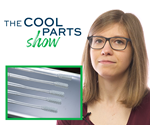More Sustainable Manufacturing Through 3D Printing (Video #3)
3D printing can support the circular economy by offering an alternative to centralized mass production. More in this video, part of our series on 3D Printing and the Circular Economy.
Traditionally, manufacturing has occurred in large factories, with production centralized at the location that contains all the needed tools and equipment to make the product. While effective for large-scale production, this method requires a large up-front investment in infrastructure and leaves manufacturers potentially vulnerable to supply chain disruption.
3D printing can be a more sustainable alternative. It is a digital manufacturing process, which avoids the use of tooling and opens the door to decentralized and distributed manufacturing. Learn more in the video below, part of our series on 3D Printing and the Circular Economy.
Resources and Related Links
- Videos in this series: What Is the Circular Economy? | Materials | Design | Manufacturing | Product | End-of-Life
- An example of distributed manufacturing: COVID-19 test swabs
- Reshored manufacturing of custom shoes, made on demand
- Production 3D printers optimized for energy consumption
Transcript
Welcome to our video series on 3D printing and the circular economy. In this video, we'll talk about how 3D printing can be a more sustainable method for manufacturing.
If you think about traditional manufacturing, goods are often made in one large facility in one central location and shipped all over the world. That can be a cost effective way of doing business. But if anything happens to disrupt that supply chain, say a global pandemic, it's going to be much more difficult to get those products out everywhere that they need to go as quickly as you might like.
3D printing has a couple of advantages over that model. First of all, it's a digital process. That means it's not reliant on hard tooling like molds or dies. If you have the right printer, the right material and the part file you can make that part anywhere in the world.
Second, 3D printing allows you to produce locally. If you're not beholden to that hard tooling, then you don't need one central factory. You could have smaller 3D printing facilities spread throughout the world and very quickly and easily shift production to wherever it needs to go.
Finally, 3D printing allows you to make it on demand. You don't need a big warehouse full of inventory ready to ship at a moment's notice. You can wait for the orders to come in produce the part quickly and then send it to somebody local who needs it.
3D printing offers a more sustainable manufacturing method because it allows you to make exactly what is needed, where it is needed and only when and if it is needed. Learn more at AdditiveManufacturing.Media and gbm.media/circularAM. Thanks for watching.
Related Content
-
ActivArmor Casts and Splints Are Shifting to Point-of-Care 3D Printing
ActivArmor offers individualized, 3D printed casts and splints for various diagnoses. The company is in the process of shifting to point-of-care printing and aims to promote positive healing outcomes and improved hygienics with customized support devices.
-
With Electrochemical Additive Manufacturing (ECAM), Cooling Technology Is Advancing by Degrees
San Diego-based Fabric8Labs is applying electroplating chemistries and DLP-style machines to 3D print cold plates for the semiconductor industry in pure copper. These complex geometries combined with the rise of liquid cooling systems promise significant improvements for thermal management.
-
At General Atomics, Do Unmanned Aerial Systems Reveal the Future of Aircraft Manufacturing?
The maker of the Predator and SkyGuardian remote aircraft can implement additive manufacturing more rapidly and widely than the makers of other types of planes. The role of 3D printing in current and future UAS components hints at how far AM can go to save cost and time in aircraft production and design.

.jpg;width=70;height=70;mode=crop)












